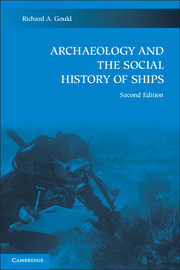Book contents
- Frontmatter
- Contents
- List of figures
- List of tables
- Acknowledgments
- Introduction: Toward a higher standard
- 1 Interpreting the underwater archaeological record
- 2 Underwater archaeology: The state of the art
- 3 Ships and shipwrecks: Basic mechanics
- 4 The archaeology of small watercraft
- 5 The earliest ships
- 6 Shipwrecks and our understanding of ancient trade
- 7 Sailing ships of the Middle Ages
- 8 Ships of the great age of sail
- 9 From sail to steam in maritime commerce
- 10 New technologies and naval warfare
- 11 The archaeology of maritime infrastructure
- 12 The future of shipwreck archaeology
- References cited
- General index
- Ship and site index
Introduction: Toward a higher standard
Published online by Cambridge University Press: 05 June 2012
- Frontmatter
- Contents
- List of figures
- List of tables
- Acknowledgments
- Introduction: Toward a higher standard
- 1 Interpreting the underwater archaeological record
- 2 Underwater archaeology: The state of the art
- 3 Ships and shipwrecks: Basic mechanics
- 4 The archaeology of small watercraft
- 5 The earliest ships
- 6 Shipwrecks and our understanding of ancient trade
- 7 Sailing ships of the Middle Ages
- 8 Ships of the great age of sail
- 9 From sail to steam in maritime commerce
- 10 New technologies and naval warfare
- 11 The archaeology of maritime infrastructure
- 12 The future of shipwreck archaeology
- References cited
- General index
- Ship and site index
Summary
There has been important new work in maritime archaeology in the 10 years that have passed since the publication of the first edition of Archaeology and the Social History of Ships. How have these findings “made a difference” to our knowledge of what happened in the past? And how have they affected the conduct of maritime archaeology? There have been new discoveries, such as the much-publicized location, recording, and recovery of the Confederate Civil War submarine, CSS Hunley. There have also been detailed major reports on shipwrecks reported earlier, such as the Viking vessels at Roskilde Fjord, Denmark, the royal warship Vasa in Stockholm, and – perhaps most important of all – the shipwrecks and boats of Basque origin at Red Bay, Labrador. The cumulative effect of these reports and findings has been to raise the empirical standard of shipwreck archaeology as a credible historical science.
Just as with the first edition, this book does not attempt to be encyclopedic. It is a critical commentary about how empirical, scientifically grounded archaeology affects what we know about our past. Given limitations of space and format, this kind of review is selective. Specific shipwreck studies and other shipwreck-related findings were selected for their relevance to some of the dominant issues of social history. Archaeology is a powerful tool for testing our ideas about what happened in the past, so I chose examples that offered special insights or raised major questions about the characteristics and development of maritime societies.
- Type
- Chapter
- Information
- Archaeology and the Social History of Ships , pp. 1 - 8Publisher: Cambridge University PressPrint publication year: 2011



